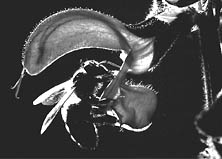The changelings
 segmentation and varying levels of similarity or difference between the segments are the basic characteristics of the insect body structure. For instance, a typical fly has a head, three thoracic segments and eight to nine abdominal segments. Each thoracic segment carries a pair of legs; the last two carry a pair of wings and a pair of balancers as well. All two-winged insects are believed to have evolved from their primitive four-winged ascendants (like dragonflies of today), which, in turn, evolved from insects with three pairs of wings and nine pairs of "winglets.'
segmentation and varying levels of similarity or difference between the segments are the basic characteristics of the insect body structure. For instance, a typical fly has a head, three thoracic segments and eight to nine abdominal segments. Each thoracic segment carries a pair of legs; the last two carry a pair of wings and a pair of balancers as well. All two-winged insects are believed to have evolved from their primitive four-winged ascendants (like dragonflies of today), which, in turn, evolved from insects with three pairs of wings and nine pairs of "winglets.'
Any significant evolutionary modifications in the body must come about via a genetic mutation. Therefore, scientists are currently attempting to find the genes that led to such striking modifications in insect body pattern while retaining the basic structure. Thanks to the pioneering work of E B Lewis of California Institute of Technology, usa, "homeotic genes' which, when mutated, can result in the replacement of one body segment by another.
In a surprising development, B Starling Emerald and J K Roy of Banaras Hindu University's cytogenics laboratory show that similar changes can be caused by the misexpression of an entirely different class of genes, the so-called "developmental genes' (Nature Vol 389, No 6652). Working with the fruit fly Drosophila melanogaster , Emerald and Roy looked at wingless genes. These, when mutated, lead to absence of wings. The team also studied engrailed genes which make the front and the rear of each body segment distinct.
First, a small patch of cells expressing the engrailed gene within the front half of an otherwise normal wing or balancer was generated. In the case of the wing, such patches "forgot' that they were in the front half, and instead differentiated as if they were in the rear half. But when a similar patch was generated in the front half of a balancer, the engrailed -expressing tissue displayed characteristics of a wing. In other words, the experiment had caused a balancer-to-haltere (halteres are knobbed filaments which in two-winged insects take the place of the rear wings) transformation very similar to that caused by a homeotic gene.
The experiments with the wingless gene were carried out somewhat differently. Flies were raised containing different combinations of known wingless mutations. The results were equally unexpected, and included the development of wing-like structures in the first thoracic segment and the transformation of legs to balancers in the third thoracic segment. The results reveal that the genetic changes responsible for the evolution of the fly in its current state may have been quite varied.
Apart from changes in homeotic gene expression, changes in the regulatory pattern of other developmental genes
